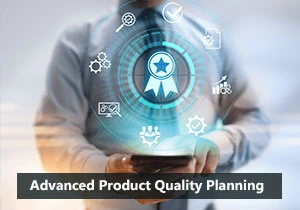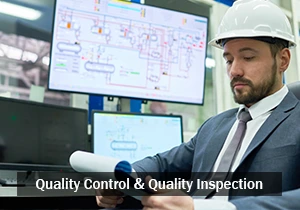VDA 6.3 Process Audits in the Automotive Industry
The VDA 6.3 process audit, established by the Verband der Automobilindustrie (German Association of the Automotive Industry), is a standard for evaluating and enhancing processes within the automotive industry. This rigorous audit is designed to extend its meticulous scrutiny far beyond the assembly line, encompassing the entire value chain from supplier management to final product delivery. By focusing on every operational aspect, VDA 6.3 ensures that organizations not only meet but exceed the highest quality standards. It promotes efficiency and helps in mitigating risks through comprehensive assessments and continuous improvements.
In an industry renowned for its precision and high demands, the VDA 6.3 process audit serves as a strategic ally. It provides a structured framework for organizations to achieve operational excellence, maintain competitiveness, and foster a culture of quality.
As the automotive industry evolves with advancements in technology and increasing regulatory requirements, the VDA 6.3 process audit remains an essential tool. It guides companies towards a future of unparalleled quality, ensuring that every cog in the organizational machine operates seamlessly and effectively.
Let's delve into the details of this innovative technique and understand its significance.
Which Companies Implement VDA 6.3?
VDA 6.3, developed by the German automotive industry association, is predominantly used by German automakers such as Mercedes-Benz, BMW, Daimler, Opel, and Volkswagen. However, it is also applicable to any company striving for excellence in process management, regardless of geographical location or industry.
Why Is VDA 6.3 Important?
VDA 6.3 transcends being a mere compliance checkbox; it is a catalyst for enhancing quality standards. The automotive industry, known for its precision and exacting demands, finds in VDA 6.3 a partner in excellence. Through rigorous assessments, it ensures that every component of the organizational machinery operates with calibrated precision.
What Constitutes a VDA 6.3 Process Audit?
A VDA 6.3 process audit is designed to ensure that every step in the value chain aligns with the highest quality standards, driving continuous improvement and risk mitigation. Here are the key components that make up a VDA 6.3 process audit:
1. Process Analysis
VDA 6.3 delves deep into processes, identifying inefficiencies and bottlenecks. This thorough analysis fosters a culture of continuous improvement.
2. Risk Management
VDA 6.3 confronts business risks head-on through a robust risk management framework, fortifying organizations against potential pitfalls.
3. Competence Evaluation
In the automotive industry, competence is crucial. VDA 6.3 evaluates personnel competence, ensuring that each team member excels in their role.
What Challenges Arise with VDA 6.3 Adoption?
Implementing VDA 6.3, while beneficial, can present several challenges for organizations. These challenges must be effectively managed to fully leverage the advantages of this rigorous audit standard. Here are the primary challenges that organizations may face:
1. Resistance to Change
Organizations accustomed to conventional auditing practices may resist the depth and thoroughness of VDA 6.3.
2. Skillset Alignment
The skills required for VDA 6.3 implementation may not align with existing competencies within the organization, posing a challenge.
3. Investment Costs
Implementing VDA 6.3 requires significant time and financial investment, which some organizations may hesitate to commit.
4. Documentation Demands
VDA 6.3 demands meticulous documentation, which can overwhelm teams used to less detailed reporting.
Read More: What Does a Quality Engineer Do?
How Has VDA 6.3 Evolved Over Time?
First published in 1998, VDA 6.3 has undergone several revisions, with the latest in January 2023. Key changes include:
Consistency in Core Elements
The classification system (A, B, C) and the structure of the questionnaire remain unchanged, maintaining continuity.
Evolutionary Changes
- New questionnaire addressing software considerations, reflecting the industry's reliance on software in automotive processes.
- Content alignment with Automotive SPICE® and VDA MLA for an integrated quality management system.
- Addition of requirements related to purchasing activities in P3 and P4.
- Guidance for conducting remote audits, reflecting changing work dynamics.
- Streamlining by removing Chapter 4 (audit process).
- Chapter 8 (process audit services) moved to a separate publication (VDA 6.8).
- Glossary transferred to the higher-level VDA QMC online glossary for accessibility.
- Partial reassignment of questions of special significance (*-marked) and potential analysis.
Revised Questionnaire
The 2023 revision includes:
- 59 questions.
- 17 redefined *-questions.
- 35 questions focusing on potential analysis with a shifted "assessment threshold."
- Integration of software-related requirements.
- Specific requirements for purchasing activities in P3 and P4.
What are the Certification Requirements for VDA 6.3?
VDA 6.3 certification is comprehensive and involves:
- Choice between IATF 16949:2016 or VDA 6.1 for certification.
- Product suitability assessment through Formula Q-capability/Q-capability software.
- Internal audits aligning with IATF 16949:2016, Formula Q-capability, or KVP Continual Improvement Process.
- Annual self-assessment using Q-capability with thorough documentation.
- Systematic risk mitigation in the supply chain.
What Are the Key Focus Areas for VDA 6.3 Certification?
VDA 6.3 certification is comprehensive and requires organizations to adhere to several critical focus areas. These focus areas ensure that processes within the organization meet the highest standards of quality and efficiency. Here are the primary focus areas for VDA 6.3 certification:
- IATF 16949:2016 or VDA 6.1: Organizations can choose between the IATF 16949:2016 standard or VDA 6.1 for their certification. This choice provides flexibility in aligning with the most suitable quality management system.
- Formula Q-capability/Q-capability Software: A key requirement is assessing product suitability through Formula Q-capability or Q-capability software. This ensures that products meet the necessary quality and performance standards.
- Alignment with Standards: Internal audits must align with IATF 16949:2016, Formula Q-capability, or the KVP Continual Improvement Process. These audits help maintain consistency and quality across all processes.
- Q-capability Self-Assessment: Organizations must conduct an annual self-assessment using Q-capability. This self-assessment should be thoroughly documented to ensure transparency and continuous improvement.
- Systematic Risk Management: Identifying and systematically mitigating risks in the supply chain is crucial. This focus area ensures that potential issues are proactively addressed to prevent disruptions.
- Robust Documentation: Organizations must maintain robust documentation of development processes in automobile manufacturing. This documentation is essential for transparency and accountability.
- Streamlined Procedures: Streamlining supply and distribution procedures is critical for efficiency. This focus area ensures that these processes are optimized for maximum effectiveness.
- Stringent Quality Assurance: Implementing stringent quality assurance measures is a cornerstone of VDA 6.3 certification. These measures ensure that products consistently meet high standards.
- Clear Delineation: Clear delineation of responsibilities within the supply chain helps maintain accountability and ensures that each stakeholder understands their role.
- Highly Skilled Staff: Recruiting and retaining highly skilled and experienced staff is essential. A well-trained workforce is a cornerstone of organizational strength and quality.
- Ongoing Education: Emphasis on continuous training and development ensures that the workforce remains competent and capable of meeting the evolving demands of the industry.
Embracing VDA 6.3 certification is a strategic leap for automotive companies, elevating business operations to meet global quality benchmarks. VDA 6.3 employs a rigorous scoring system, where non-compliance with essential process control standards leads to automatic disqualification. This underscores a steadfast commitment to excellence in the ever-evolving automotive landscape.
The VDA 6.3 process audit ensures that product manufacturing embodies the German precision, workmanship, and quality excellence for which German companies are renowned. AMREP, your strategic partner in quality, is dedicated to the relentless pursuit of perfection, with experienced engineers adept at deploying VDA 6.3. Also read: How the A3 Process Revolutionizes Supplier Management.
Drive Quality Excellence with VDA 6.3 and AMREP Mexico
VDA 6.3 process audit is not just a compliance requirement but a strategic instrument that propels the automotive industry towards excellence. By ensuring meticulous evaluation and enhancement of processes, it helps organizations meet the highest standards of quality and efficiency. At AMREP Mexico, we are dedicated to supporting our clients in achieving these standards through expert guidance and comprehensive quality control services. Embrace the VDA 6.3 process audit with AMREP Mexico and steer your organization towards a future of unparalleled quality and precision.
Sources
VDA 6.3 based process audits as a tool for supplier evaluation. https://www.sszp.eu/wp-content/uploads/2013_conference_MaZP__p-56__Surinova.pdf
Review of Specialized Standards in Quality Management System Audits in Automotive Production. https://intapi.sciendo.com/pdf/10.2478/rput-2013-0036
The importance of a production process quality audit in an automotive company. https://ojs.ahe.lodz.pl/index.php/ziwgib/article/view/427


